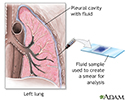Pleural fluid smear
Pleural fluid smear is a laboratory test to check for bacteria, fungi, or abnormal cells in a sample of the fluid that has collected in the pleural space. This is the space between the lining of the outside of the lungs (pleura) and the wall of the chest. When fluid collects in the pleural space, the condition is called pleural effusion .
Pleural effusion
A pleural effusion is a buildup of fluid between the layers of tissue that line the lungs and chest cavity.

How the Test is Performed
A procedure called thoracentesis is used to get a sample of pleural fluid. The health care provider examines a sample of pleural fluid under the microscope. If bacteria or fungi are found, other methods may be used to further identify those organisms.
Thoracentesis
Thoracentesis is a procedure to remove fluid from the space between the lining of the outside of the lungs (pleura) and the wall of the chest....
How to Prepare for the Test
No special preparation is needed before the test. A chest x-ray will be performed before and after the test.
DO NOT cough, breathe deeply, or move during the test to avoid injury to the lung.
How the Test will Feel
For thoracentesis, you sit on the edge of a chair or bed with your head and arms resting on a table. The provider cleans the skin around the insertion site. Numbing medicine (anesthetic) is injected into the skin.
A needle is placed through the skin and muscles of the chest wall into the space around the lungs, called the pleural space. As fluid drains into a collection bottle, you may cough a bit. This is because your lung re-expands to fill the space where fluid had been. This sensation lasts for a few hours after the test.
Why the Test is Performed
The test is performed if you have a pleural effusion and its cause is not known, especially if the provider suspects an infection or cancer.
Normal Results
Normally, no bacteria, fungi, or cancer cells are present in the pleural fluid.
Normal value ranges may vary slightly among different laboratories. Talk to your doctor about the meaning of your specific test results.
What Abnormal Results Mean
Positive results may indicate that infection, or cancer cells, are present. Other tests can help identify the specific type of infection or cancer. Sometimes, the test may show abnormalities from conditions such as systemic lupus erythematosus .
Systemic lupus erythematosus
Systemic lupus erythematosus (SLE) is an autoimmune disease. In this disease, the body's immune system mistakenly attacks healthy tissue. It can af...

Risks
Risks of thoracentesis are:
-
Collapse of the lung (
pneumothorax
)
Pneumothorax
A collapsed lung occurs when air escapes from the lung. The air then fills the space outside of the lung, between the lung and chest wall. This bui...
 ImageRead Article Now Book Mark Article
ImageRead Article Now Book Mark Article - Excessive loss of blood
- Fluid re-accumulation
- Infection
- Pulmonary edema
-
Respiratory distress
Respiratory distress
Acute respiratory distress syndrome (ARDS) is a life-threatening lung condition that prevents enough oxygen from getting to the lungs and into the bl...
 ImageRead Article Now Book Mark Article
ImageRead Article Now Book Mark Article
References
Broaddus VC, Light RW. Pleural effusion. In: Broaddus VC, Mason RJ, Ernst JD, et al., eds. Murray and Nadel's Textbook of Respiratory Medicine . 6th ed. Philadelphia, PA: Elsevier Saunders; 2016:chap 79.
Kosowsky JM, Kimberly HH. Pleural disease. In: Marx JA, Hockberger RS, Walls RM, et al., eds. Rosen's Emergency Medicine: Concepts and Clinical Practice . 8th ed. Philadelphia, PA: Elsevier Mosby; 2014:chap 77.
-
Pleural smear - illustration
A pleural smear examines a sample of pleural fluid under the microscope to detect for abnormal organisms. The test is performed when infection of the pleural space is suspected or when an abnormal collection of pleural fluid is noticed by chest X-ray.
Pleural smear
illustration
-
Pleural smear - illustration
A pleural smear examines a sample of pleural fluid under the microscope to detect for abnormal organisms. The test is performed when infection of the pleural space is suspected or when an abnormal collection of pleural fluid is noticed by chest X-ray.
Pleural smear
illustration
Review Date: 11/19/2015
Reviewed By: Denis Hadjiliadis, MD, MHS, Associate Professor of Medicine, Pulmonary, Allergy, and Critical Care, Perelman School of Medicine, University of Pennsylvania, Philadelphia, PA. Also reviewed by David Zieve, MD, MHA, Isla Ogilvie, PhD, and the A.D.A.M. Editorial team.

